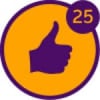Clothing for Assisted Living


Hopefully, Mom will be moving into an Assisted Living facility next month. The facility has an associated Memory Care Unit, but based on their preliminary assessment she is about average for the residents in the assisted living side so she will start out there. Now I am trying to figure out how to deal with her clothes.
First problem: What and how much should I pack? I don't really know what the expectations are for dress in assisted living. Also, I'm a guy, so packing for my mother is not an obvious thing.
Second problem: Mom has lost a lot of weight in the past couple years. The clothes in her closet are size Large but now she is a size Small or maybe XS. For two years at least she has been essentially homebound and I have only seen her wearing nightgowns. I think I will have to buy her new clothes to be presentable in Assisted Living. Is there some guidance about clothing that would be good for women with mobility issues, who will likely need some assistance with dressing? Are there stores or online sites that cater to that market?
Comments
-
When we placed dad, the MCF had a suggested list for us which was helpful. The whole process reminded me of getting my son packed for summer camp right down to the sew-on nametags.
Is this a hospitality-model AL or a higher acuity "AL for MC"/MCF? When you toured the facility, how were the other ladies dressed? In my touring, the ladies in the former wore the sorts of things women living in the community do; in the latter it was more mixed with most ladies wearing pull on elastic waist slacks, easy-on tops, simple housecoat dresses and some kind of slip on or Velcro shoe. Alfred Dunner was one brand we bought for my MIL as the quality was such that it could hold up under the kind of industrial laundry her SNF had. It's a department store brand-- Macy's, Kohl's Dillard's etc. might carry it. Dad's MC had the aides do laundry in a home-like setting-- many of the ladies living there helped with this as an activity but nobody was ironing, so knits are a good choice.
Buck and Buck is an online company that sells similar adaptive clothing for folks with more serious mobility issues. I'm told their quality is good and as a bonus, they'll sew-in the labels if you buy them there.
Women's Clothing Adaptive Clothing for Seniors, Disabled & Elderly Care (buckandbuck.com)
I wouldn't bring anything valuable or "nice". When dad needed something nicer than his usual sweats for an appointment, she'd bring it all to him and then take it home with her to launder and press. We did have some of dad's things go missing so it's critical to label everything. Al and MCFs will have folks who "shop" other residents' rooms. For some reason dad's slippers went missing a lot along with a portrait of my mom.
Also, don't bring any jewelry of any value. With my one aunt, we substituted her engagement ring for a similar CZ costume version several times when it disappeared.
HB
0 -
Hi,
It’s a good plan to keep things simple. Making decisions for the person with dementia becomes harder as time goes by, and lots of choices makes it difficult to dress. Also assume that outfits won’t get put in the laundry each day- things may get recycled.
If I could do it over again I’d take much less clothing, and just 2 pairs of shoes, but I was trying to preserve a sense of normalcy for my mom and I took a lot, and now am afraid to remove them- she was in a stage for a while where she would go through everything at night.
Something I noticed is that my mom will not use things she doesn’t recognize as hers. So while replacing her LLBean tees is pretty easy, buying anything that doesn’t match her go-to things means she usually won’t wear them. Same with things in her room- laundry didn’t go in the new hamper I had bought, but when switched out to what she had always used she would use it. She can’t manage a phone or tv now.
I do see people in her AL in their nighties, and so if your mom’s resistant to attempts to get her into street clothes it’s ok not to fight that battle.
amazon sells washable, stick- on clothing labels. I find the slightly bigger ones are easier to write on— you can attach them to the bottom hem of tee shirts rather than up by the neckline. Don’t forget to label sheets, etc. Also buy some chucks for between the sheets and her mattress, which should be in a waterproof cover. Chucks can be either wahable or disposable. My mom has a loveseat, and I wrapped the cushions in garbage bags, zipped them back in their covers, put a washable chuck where she always sits, and covered it all with a cheap one size fits all cover.
0 -
Hello CatOut - I agree with others to keep clothing simple. My mom is not yet in an ALF, but I am preparing for the inevitable and getting her "wardrobe" ready.
My approach is that I only get her solid black color leggings or yoga pants with an elastic waist band. This makes it easy to get on and off, and easy to fit most sizes. Also, black can be worn with most any other color so it should be presentable and no worry about the bottoms mismatching the top. You can find these affordably at most of the chain stores or online. They come in various lengths from ankle length to mid-calf. I went to the store once and got several pair in the same size. As for the tops, I choose a solid color or small print that is a pull over, so no buttons, snaps, ties, or zip ups.
As also said, think about getting name tags, and putting them inside the clothes to ensure when the laundry is done, that their belongings more easily find their way back to them. I just ordered some online. Some are iron on and some are sew on, or stick on. I think it might be best to label whatever you can.
1 -
You might also want to consider that as people get older they tend be "cold" and to dress more warmly. This seems especially true for PWD, my DW is always cold (she's only 71). DW is now in memory care and I notice the aides always dress her in her warmer clothes, tee shirts and thin pants are rarely used. As noted by others, pants with elastic waist, simple pull over tops, slip on shoes. At some point aides may need to start dressing her or at least helping and those choices will make it easier for them. Only a small wardrobe is necessary, again if aides are involved, they probably won't spend a lot of time on putting together a wide range of outfits. I guarantee the other residents won't notice frequently repeated outfits.
It can take awhile to get customized labels, the ones I got off Amazon came from Spain! and took several weeks. Amazon carries stick on clothing labels made by Avery. I was skeptical, but they have held up well and you can use them for shoes, brushes, and stuff as well as clothes, that iron or sew on labels don't work for.
0 -
What you get depends a lot on the facility. I don't worry about labels at my parents' facility because the clothes are washed room by room, so things don't get mixed up. (It is a smaller facility.). My mom likes Alfred Dunner clothes, but they do run a little big, so beware. I get them from Kohl's but buy them online so that I can get things that are classy looking. Mom likes to look nice. They are easy to return since there is a Kohl's nearby. I had to do that to find the right size of pants recently. I agree in keeping it simple. I keep a dresser at my house with things that my parents might want but should not keep in a facility. That works very well since I am not far away. I think that pull-on pants and stretchy tops are good. Also, a few washable sweaters or zippered sweatshirts would be nice. My mom prefers the zippered sweatshirts with embroidered designs to make a bit of a fashion statement! I also bought Mom several pairs of socks for her orthotic shoes. They all have designs and are a little heavier than what she was wearing, so her narrow feet fit in the shoes nicely with the heavier socks. She also has a jacket and a coat, and I will be buying her a garden hat to wear in the courtyard.
0 -
A good tip someone in PT gave me: slip-on shoes with backs. Clogs, mules, sandals, will be trip hazards when your loved one doesn't put their shoes on properly, or when their balance and walking starts to falter. The slip-on shoes can be slipped on easily by staff. There are a lot of nice brands that you can buy online: Skechers, Easy Spirit. Look on Macys.com and 6pm.com.
I buy mom Hanes slip-on slacks with elastic waistbands in navy and black from Amazon.
I buy blouses, shirts, and sweaters at Kohl's and at thrift stores. This stuff really takes a beating in the AL industrial washers, so nothing expensive. I cut off the buttons and sew on Velcro closures on the front so it's easy for aides to dress her. It's become hard to slip things over her head.
Zip-up sweatshirts are good, though mom isn't too fond of them as she likes to dress more formally.
0 -
Thanks for all the helpful comments. When getting Mom ready for a doctor's appointment a couple days ago, my suspicions were confirmed that she literally has nothing to wear. Her closet is full of clothes in size L and XL, and she now needs size XS. She probably has not worn "street-clothes" in about two years. I was in a rush so I got her some simple t-shirts and shorts from Target so we could make the doctor's appointment. But I will use the advice on this thread to get more stuff.
I did ask Assisted Living for a packing list, but the list just said "clothes". Here is what I am thinking, please let me know if you have other suggestions.
5 short-sleeved shirts
5 long-sleeved shirts
5 pants
5 shorts
1 pair shoes
5 nightgowns
0 -
I would maybe add a few shirts and pants. Some PWD spill and go through multiple outfits per day. Keep it comfy and easy to launder. Everything gets laundered in a hot dryer so focus on things that will hold up and not need any extra care. I bought mom a new wardrobe when she entered a facility. Elastic waist pants, cotton Tees in long and short sleeves, and a couple cardigans. She ended up wearing slippers a lot more than shoes, kind of a moccasin style slipper with good tread for traction. Buy all the same socks to make matching easy. My experience with ALs is there is a huge range of what women wear. Some folks are there because of mobility issues and are cognitively intact so they might wear really nice things still and take great care with their appearance and hygiene. Others are way down the dementia road, close to being moved to MC and they wear sweatpants and may look a bit disheveled. It probably depends on if it is ahigh acuity AL or more of a hospitality model one.
I took her winter stuff out when the seasons changed or else they often wandered off and we couldn't find two gloves etc. I took her boots, heavy coat, hat and gloves home for the summer months. Also consider what she may need for any outings. My mom went on a lot in the beginning, and needed a windbreaker and sun hat.
0 -
I would ask about the laundry routine. Dad's MCF did laundry on the unit in a standard Maytag washer/dryer; typically doing one resident's clothing and bedding at a time once a week. In this scenario, you wouldn't have enough. When dad was in rehab, clothing was done communally in large industrial washers and dryers which beat clothing up. My MIL's SNF did this as well, so my SIL did her laundry.
She's going to need panties if she's not in incontinence briefs full time. If she doesn't wear a bra, you should consider getting her very soft ladies undershirts or camisoles to wear under her shirts for modesty and also to keep shirts from chafing tender skin. Five nightgowns would be a bit generous unless she is soaking through 1-2 a night. She'll need a robe. If she'll be getting shower assistance, she might wear while the aide assists.
She's going to probably need a couple of cardigans. These could be sweaters, knits or sweatshirt fleece; pockets are good for tissues.
For shoes, they may have a preference. PTs in such places tend to suggest a supportive athletic shoe with Velcro closures. If she has slippers, you want something that covers the whole foot with a non-slip sole.
I'd err on the side of more pants and fewer shorts. As she progresses, falls will happen and having the skin covered is a good thing. My own mom missed a step climbing up onto a train platform 10 days ago and we're still dealing with a nasty skin tear.
More tops/shirts make sense. PWD tend to spill or get messy when eating, she might go through a couple on a bad day.
Good luck.
HB
0 -
A couple things to add: if she's lost a lot of weight recently, she might be thicker in the middle and thinner in her arms and legs and backside. Pull on pants are great but look for "old lady style" that have a little extra material at the top to go over her tummy. We ordered from the Blair catalog for my mom. Re shirts - a generous neck hole, or quarter zip style, is helpful when people don't have great use of their arms and shoulders. Try to find clothes that will feel familiar to her. Bras - if she needs/wants to wear one, the CNA or whoever is helping her get ready in the morning can help you figure out size. My mom needed to wear one and I was able to find some that closed in front (Hanes/Bali outlet). Undies - funny story, my mom hadn't replaced her underwear in YEARS and I had the chance to ditch all the old ones and buy new. I bought a lot because I knew incontinence was becoming an issue, and a couple months later she went to disposable briefs. I ended up donating several packages of brand new underwear in the package to the womens shelter.
Another thought: I remember my mom sitting there fiddling with her fingers and comforting herself by patting her soft sweater or lap throw. If she's someone who might want a texture to play with, you can probably find an acrylic knit sweater or sherpa fleece that feels good under her hands or against her skin.
0
Commonly Used Abbreviations
DH = Dear Husband
DW= Dear Wife, Darling Wife
LO = Loved One
ES = Early Stage
EO = Early Onset
FTD = Frontotemporal Dementia
VD = Vascular Dementia
MC = Memory Care
AL = Assisted Living
POA = Power of Attorney
Read more
Categories
- All Categories
- 592 Living With Alzheimer's or Dementia
- 318 I Am Living With Alzheimer's or Other Dementia
- 274 I Am Living With Younger Onset Alzheimer's
- 16.9K Supporting Someone Living with Dementia
- 5.6K I Am a Caregiver (General Topics)
- 8.2K Caring For a Spouse or Partner
- 2.7K Caring for a Parent
- 225 Caring Long Distance
- 156 Supporting Those Who Have Lost Someone
- 17 Discusiones en Español
- 5 Vivir con Alzheimer u Otra Demencia
- 4 Vivo con Alzheimer u Otra Demencia
- 1 Vivo con Alzheimer de Inicio Más Joven
- 12 Prestación de Cuidado
- 3 Soy Cuidador (Temas Generales)
- 8 Cuidar de un Padre
- 23 ALZConnected Resources
- View Discussions For People Living with Dementia
- View Discussions for Caregivers
- Discusiones en Español
- Browse All Discussions
- Dementia Resources
- 8 Account Assistance
- 15 Help
















